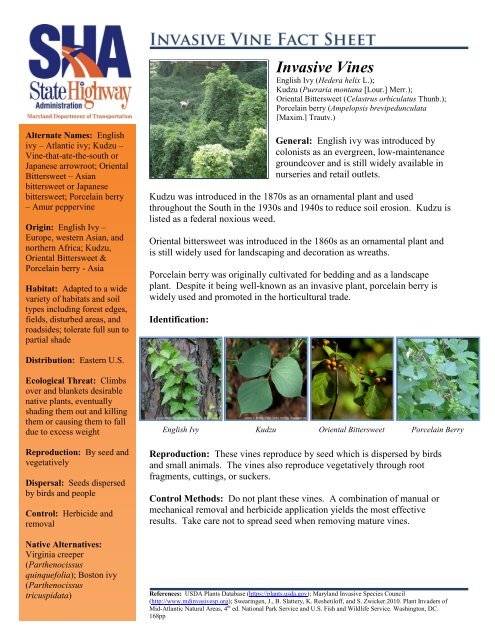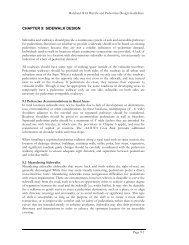Invasive Vines
Invasive Vines
Invasive Vines
You also want an ePaper? Increase the reach of your titles
YUMPU automatically turns print PDFs into web optimized ePapers that Google loves.
Alternate Names: English<br />
ivy – Atlantic ivy; Kudzu –<br />
Vine-that-ate-the-south or<br />
Japanese arrowroot; Oriental<br />
Bittersweet – Asian<br />
bittersweet or Japanese<br />
bittersweet; Porcelain berry<br />
– Amur peppervine<br />
Origin: English Ivy –<br />
Europe, western Asian, and<br />
northern Africa; Kudzu,<br />
Oriental Bittersweet &<br />
Porcelain berry - Asia<br />
Habitat: Adapted to a wide<br />
variety of habitats and soil<br />
types including forest edges,<br />
fields, disturbed areas, and<br />
roadsides; tolerate full sun to<br />
partial shade<br />
Distribution: Eastern U.S.<br />
Ecological Threat: Climbs<br />
over and blankets desirable<br />
native plants, eventually<br />
shading them out and killing<br />
them or causing them to fall<br />
due to excess weight<br />
Reproduction: By seed and<br />
vegetatively<br />
Dispersal: Seeds dispersed<br />
by birds and people<br />
Control: Herbicide and<br />
removal<br />
Native Alternatives:<br />
Virginia creeper<br />
(Parthenocissus<br />
quinquefolia); Boston ivy<br />
(Parthenocissus<br />
tricuspidata)<br />
<strong>Invasive</strong> <strong>Vines</strong><br />
English Ivy (Hedera helix L.);<br />
Kudzu (Pueraria montana [Lour.] Merr.);<br />
Oriental Bittersweet (Celastrus orbiculatus Thunb.);<br />
Porcelain berry (Ampelopsis brevipedunculata<br />
[Maxim.] Trautv.)<br />
General: English ivy was introduced by<br />
colonists as an evergreen, low-maintenance<br />
groundcover and is still widely available in<br />
nurseries and retail outlets.<br />
Kudzu was introduced in the 1870s as an ornamental plant and used<br />
throughout the South in the 1930s and 1940s to reduce soil erosion. Kudzu is<br />
listed as a federal noxious weed.<br />
Oriental bittersweet was introduced in the 1860s as an ornamental plant and<br />
is still widely used for landscaping and decoration as wreaths.<br />
Porcelain berry was originally cultivated for bedding and as a landscape<br />
plant. Despite it being well-known as an invasive plant, porcelain berry is<br />
widely used and promoted in the horticultural trade.<br />
Identification:<br />
English Ivy<br />
Kudzu<br />
Oriental Bittersweet<br />
Porcelain Berry<br />
Reproduction: These vines reproduce by seed which is dispersed by birds<br />
and small animals. The vines also reproduce vegetatively through root<br />
fragments, cuttings, or suckers.<br />
Control Methods: Do not plant these vines. A combination of manual or<br />
mechanical removal and herbicide application yields the most effective<br />
results. Take care not to spread seed when removing mature vines.<br />
References: USDA Plants Database (https://plants.usda.gov); Maryland <strong>Invasive</strong> Species Council<br />
(http://www.mdinvasivesp.org); Swearingen, J., B. Slattery, K. Reshetiloff, and S. Zwicker.2010. Plant Invaders of<br />
Mid-Atlantic Natural Areas, 4 th ed. National Park Service and U.S. Fish and Wildlife Service. Washington, DC.<br />
168pp

















